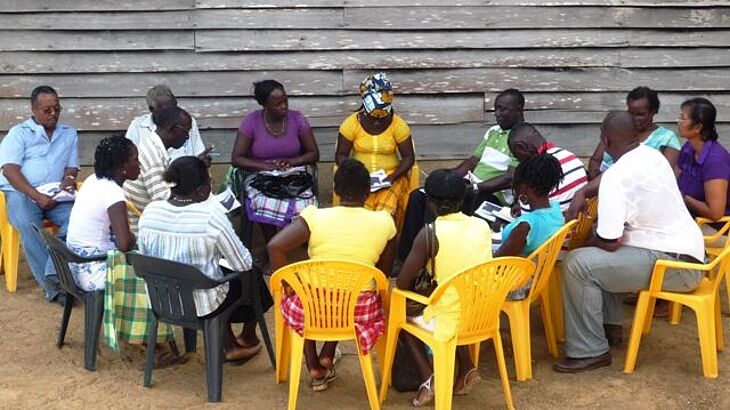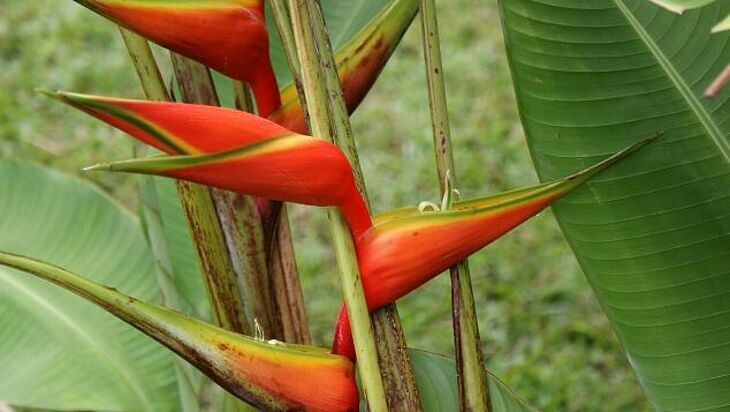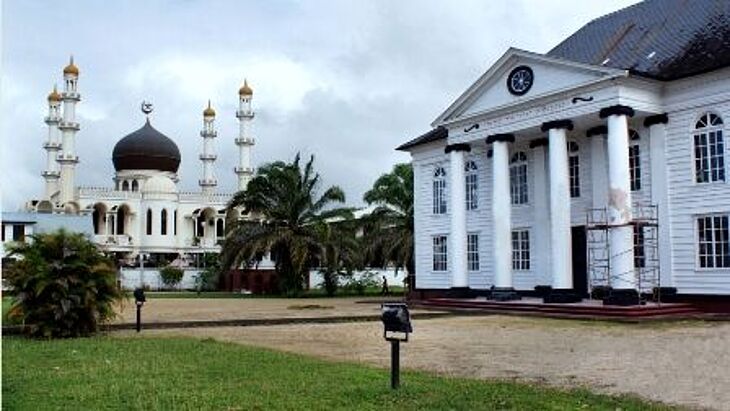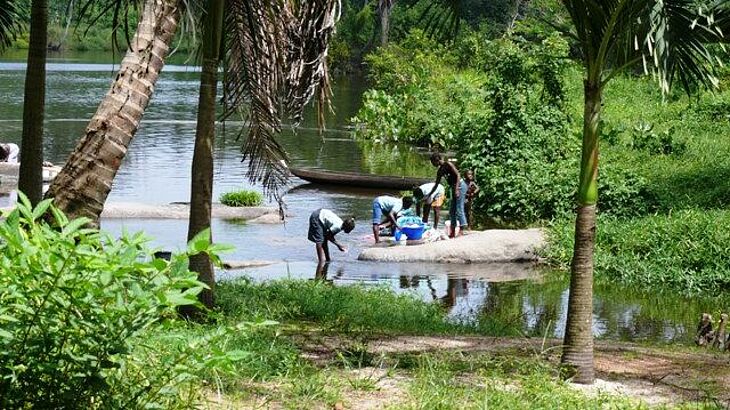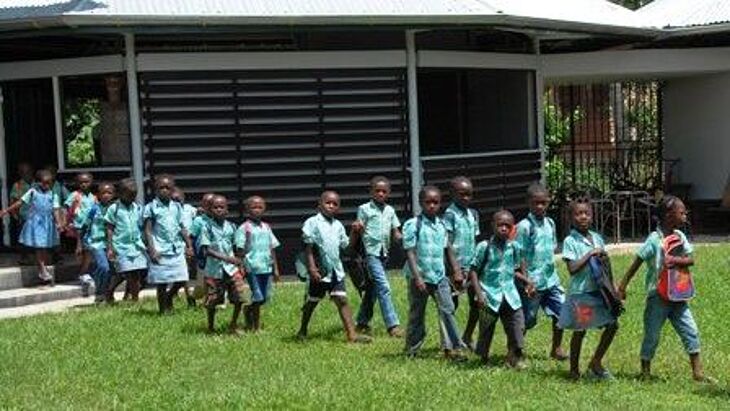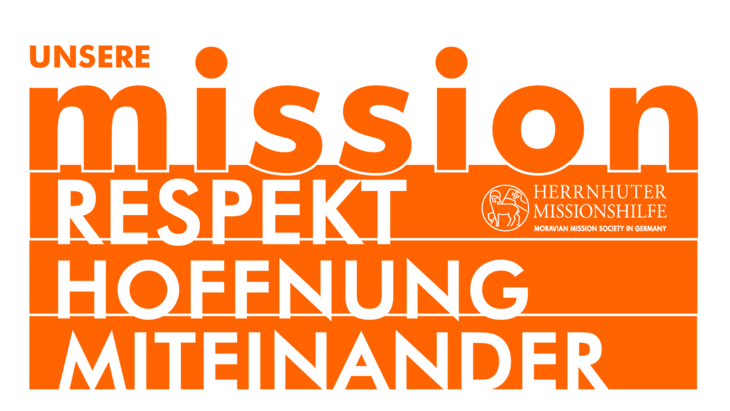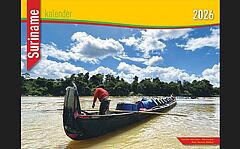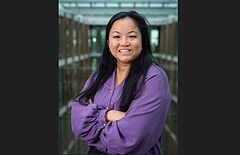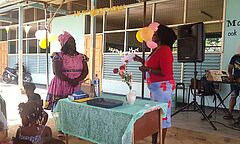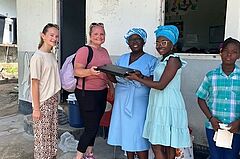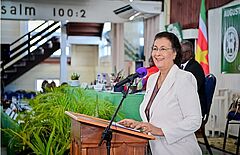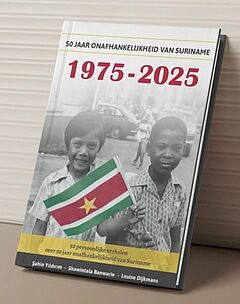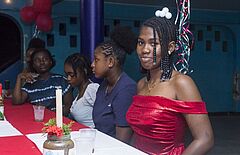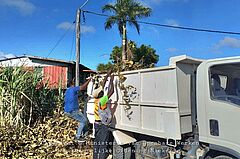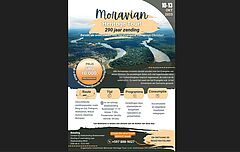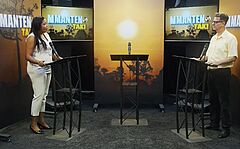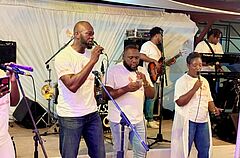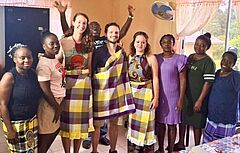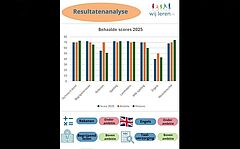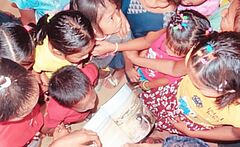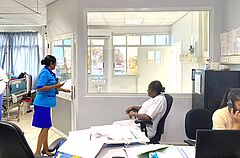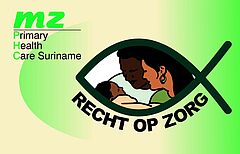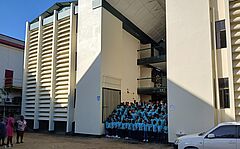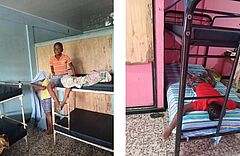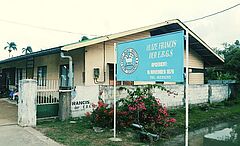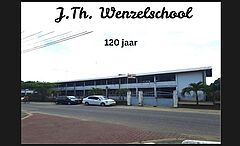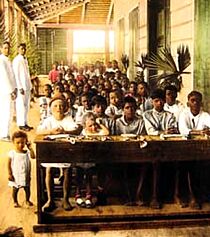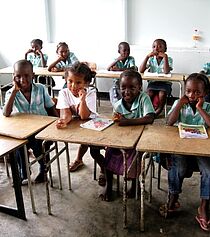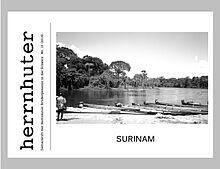Suriname

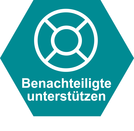
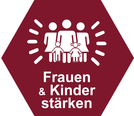

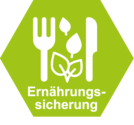
Suriname
If you are looking for the global village, Suriname is the place to be. There are few countries in the world that have such a great diversity of peoples and nations, languages and cultures, colors, shapes and scents as this small country in the north of South America. Rarely is this country in the headlines, which is why most people do not know it at all. Despite the different origins and character of its people, Suriname has been able to resolve almost all conflicts peacefully in the past, which is beautifully expressed by the Flag of Independence (in use until 1975).
Pictures Suriname
Suriname - Country and people
Suriname borders the Atlantic Ocean to the north and Brazil to the south. With an area of 164,000 m2 (twice the size of Bavaria), it is the smallest independent country in South America. Behind a marshy coastal plain no more than 80 km wide, the land rises in steps to an altitude of 1,280 meters. The climate is tropical; the air is extremely humid. The small rainy season lasts from the beginning of December to the beginning of February, and the big rainy season from the end of April to the middle of August. The average temperature varies between 24 and 36 degrees Celsius.
The rivers Suriname, Saramacca and Coppename as well as the border rivers Corantijn and Marowijne not only divide the country, they are also the most important traffic routes into the interior. About 80% of the area is covered with almost impenetrable tropical rainforest and is extremely sparsely populated. Flora and fauna possess a diversity of shapes, colors and scents that can hardly be surpassed.
Suriname is a parliamentary democracy with only one chamber, the National Assembly. It is headed by a president with numerous powers. Besides the official language Dutch, the creole language Sranan Tongo (= Surinaams or also "Negro English") is widely spoken as a lingua franca. It consists of a mixture of English, Portuguese, Dutch and African elements. With its Singi Buku published in 1781 and its Bible translation, the Moravian Church had a language-forming effect on the Sranan Tongo.
Of Suriname's approximately 450,000 inhabitants, nearly half live in the capital, Paramaribo. The ethnic composition of the population is diverse: 32% with African roots (Creoles and Maroons); 27% with Indian roots; 15% with Javanese roots; plus people of Chinese, Arab and European descent, as well as a few indigenous people (1.8%). About 40% of the inhabitants are Christianity; about 20% are Hindus and about 15% are Muslims. About 6 % identify themselves as adherents of traditional religions. Education is compulsory until the age of twelve. Average life expectancy is 66 years for men and 73 years for women.
The economy is dominated by small businesses, agriculture, fishing and tourism. The country's mineral resources, primarily bauxite, oil, gold and tropical woods, are exploited by domestic and foreign corporations and mainly exported. Soccer players from Suriname were and are active in many top European clubs. In terms of annual gross domestic product, Suriname ranks 75th in the world with US$4,800 per capita (for comparison: Germany 34,000 euros).
News from the projects
Commemoration: 290 years of Moravian Mission in Suriname
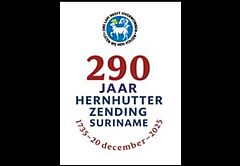
On December 20, 1735, the first German missionaries arrived in Suriname to spread the gospel in word and deed. They were Georg Bergwig, Georg Piesch, and Christoph von Larisch. From these beginnings, the Moravian Church was established in the country. The European-Continental Province ECP celebrates this beginning with the Moravians in Suriname, French Guiana, Curaçao, Aruba, and St. Maarten, all of which now belong to the Unity Province of Suriname. The anniversary theme is: “Reaching the unreached with the good news.” For the Moravian Church in Suriname is still following in the footsteps of the first missionaries and spreading the gospel throughout the country. The highlight of the celebrations will be a festive thanksgiving service on December 20, 2025, in the "Great City Church" in Paramaribo. A list of the other events is available here. A five-member committee is coordinating the celebrations.
Herman Jintie works part-time for a global organization
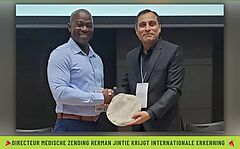
Herman Jintie, director of Medische Zending – Primary Health Care Suriname, was recently elected secretary of the board of the World Association of Cultural Psychiatry at a conference in Tokyo. This organization was founded in 2006 in response to the growing recognition of the influence of culture on mental health and illness. Culture shapes the symptoms of emotional disorders, influences susceptibility to stress, and affects the use of support services. It also shapes local health care and its institutions. Therefore, culturally sensitive approaches are essential for high-quality mental health care. Herman Jintie comes from Commewijne, not far from Paramaribo, and has been head of Medische Zending in Suriname since March 2019. More in the organization's November 2025 newsletter. See here.
Two News from Suriname
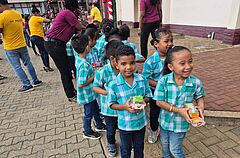
- Of course, in December 2025, the popular Advent singing by children from the Moravian Church in Suriname will once again take place throughout the country. The children's public performances at various times of the year and on various occasions are known in Suriname as “Anitri Singi Prisiri” (Moravian singing and praising). Pictures and videos here and here and here.
- On the occasion of the annual World AIDS Day on December 1, 2025, the Medische Zending (Medical Mission in Suriname) wrote on its Facebook pages: "We remain committed to raising awareness about AIDS. We advocate for education, prevention, and combating stigma related to HIV/AIDS. Everyone deserves respect, protection, and access to healthcare. No one is judged. 1) Get tested! Those who know about the infection early can be treated better. 2) No stigma and no discrimination! HIV is not a disgrace. 3) Use protection! Prevention must be a priority. 4) Support each other! Together we can build a strong, healthy society." See here.
50 years of Suriname - Churches continue to play a central role
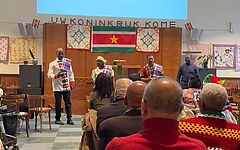
On November 27, 2025, the Dutch newspaper Reformatorisch Dagblad looked back on the celebrations marking 50 years of independence for the former Dutch colony of Suriname and wrote: “The churches played a central role in the anniversary celebrations in Suriname.” The article went on to say: "Fifty years after Suriname's independence, churches continue to play a central role, both literally and figuratively. The numerous places of worship throughout the country are tangible proof of this. And although much has changed in the area of faith in recent decades, the church will remain inextricably linked to the faith of many Surinamese people in the future. The longing for the Good News of Jesus Christ remains unbroken." See here. In the Republic of Suriname, about ten percent of Christians belong to the Moravian Church. A video of the Surinamese choir Ubuntu performing at the Moravian festive service in The Hague here.
Suriname calendar 2026 available in Zeist
The popular Suriname Calendar 2026 is now available at the museum Das Herrnhuter Haus in themoravian neighborhood of Zeist, Netherlands. It costs €15.95, excluding shipping. To the online shop here.The advertisement states: "A calendar full of photos and emotions, full of texts and experiences from Suriname. You often hear people say that once you've been to Suriname, you fall in love with the country. For years, the proceeds from the calendar have been used to support small, effective, and appealing social projects in Suriname run by the Suriname Calendar Foundation, which was founded in 1994," including projects run by the Moravian Church in Suriname in the areas of education, welfare, and health. The cover pages of the last six calendars can be viewed here. Anyone who supports the foundation with an annual donation of 26 euros will receive a free copy of the calendar as soon as it is published.
Lecture recommendation from the School Foundation of the Moravian Church in Suriname
The school foundation of the Moravian Church in Suriname recently drew the attention of its approximately 1,400 teachers to a series of lectures on bullying and classroom dynamics by Dutch educator Dr. Nathalie Hoekstra. It particularly recommended lecture no. 7: The role of the teacher in the social dynamics of a school class. The entire lecture in Dutch here. The author emphasizes that teachers are a kind of social worker and are seen as role models. Students mirror their attitudes and behavior. It is therefore extremely important how teachers interact with their students. How teachers view their students, how they reprimand and praise them, influences the behavior of the students among themselves. Dr. Nathalie Hoekstra outlines four specific ways in which teachers can specifically promote engagement, positivity, and cooperation in the classroom. Her basic thesis is that the subtle, often indirect influence of teachers controls the social dynamics of a class and the likelihood of bullying.
Gerhardt School in Coronie celebrated its 95th anniversary
On October 31, 2025, the Gerhardt School of the Moravian Church in Suriname celebrated its 95th anniversary in Hamilton (Coronie region). Lisebeth Dundas led the festive service. She wished the school many more years of success. Principal Denise Doorson and the school's teachers are committed to providing high-quality education every day. Only 34 students currently attend the small school. Frederik Riedewald, a government representative, said that he had been both a student and a teacher at this school. He urgently appealed to the operators of the “Welgelegen” (Beautiful Location) holiday resort and to the parents who work there to "bring their children to this school. In order to preserve the Gerhardt School, we must ensure that the number of children enrolled in school grows again." Local government officials agreed to commit to building a fence around the school. 17 pictures here.
Moravian Church School in Abenaston receives a gift
On October 27, 2025, an article by Samuel Wens appeared in the Surinamese online medium De ware Tijd. It reports on the distribution of school supplies and toys in Abenaston in the tropical interior of Suriname. School principal Altagracia Schmidt said, “We are delighted that our school in Upper Suriname was selected by the leadership of the Moravian Church in Suriname to receive various school supplies, including a laptop, from the Dutch foundation Hoop voor Suriname.” Preschoolers were also included, as games were distributed to them as well. According to Altagracia Schmidt, all 119 pupils at the school will make grateful use of the gifts. Marieke Rinsma from the foundation explained that the foundation is based in Deventer, home of the Go Ahead Eagles soccer club, adding: “That's why we also brought two soccer balls with us.” Lindon Ritfeld (regional representative for Upper Suriname) and Andrew Breeveld (chairman of the Moravian Church's school foundation in Suriname) expressed their gratitude on behalf of the Moravian Church. More in Dutch here.
Synod greeting from the President of the Republic of Suriname
As has only just become known, Jennifer Geerlings-Simons, initially Speaker of Parliament and elected as the new President of the Republic of Suriname on July 6, 2025, gave a welcoming address at the 20th Synod of the Unity Province of Suriname on August 27, 2025. A newspaper report in the Dagblad Suriname can be found here. The president praised the long-standing, reliable contribution of the Moravian Church in Suriname to education, health care, youth care, and elderly care in the country. She called on all synod members to reflect on the future of the country on the occasion of the 50th anniversary of the Republic of Suriname. She promised that her government would always remain in dialogue with the Moravian Church and its subordinate civil society organizations. The chair of the synod board, Kitty Derby, then responded to the president's welcoming address. She pointed out current problems facing the Moravian Church, such as land use, financing pastors' salaries, and upcoming costly renovations.
New book: 50 years of Suriname's independence (1975–2025)
November 25, Srefidensi Dey, marks exactly 50 years since Suriname became an independent republic. To mark this occasion, a special book will be published on November 19, 2025, as part of a festive presentation. It contains 50 personal stories and thus 50 perspectives that bring half a century of history and culture, contact and conflict between Suriname and the Netherlands to life. The ZZg is represented with a contribution by Daniël Claas, responsible for communications and fundraising. He recounts the centuries-long close relationship between the country of Suriname and the Moravian Church. The book deals with the history of slavery, the path to independence, migration and integration, economy and heritage preservation, culture and faith. More about the book here. Pre-orders here.
Zeist/NL: “Christmas gift campaign for Suriname 2025” launched
The Zeister Zendingsgenootschap ZZg, the missionary society of the Moravian Church in the Netherlands, reports on the launch of its Christmas campaign 2025. It writes: "The annual Christmas gift campaign for people in Suriname is in full swing. We can now describe it as a wonderful, heartwarming tradition of our society. Needy elderly people (Huize Albertine, Huize Francis, and De Unit), single mothers with children, older and younger children in boarding schools (‘Siswa Tama’) and orphanages (‘Sukh Dhaam’ and ‘Leliën-daal’) – you can bring joy to all of them with a small gift, a package of food or sweets, and a festive Christmas celebration on Christmas Eve. And every year after the holiday, we hear again how special it is that people in the Netherlands think of those in need in Suriname." See here.
Major cleaning on the grounds of Spangenberg School
To mark the 120th anniversary of the founding of the Spangenberg School in the Nickerie district of Suriname on November 1, 2025, a major clean-up of the school grounds took place recently. Some pictures can be seen here. The Ministry of Public Works and Spatial Planning and its subordinate authority, the Office for Public Green Spaces and Waste Management (OGA), were also involved. With combined efforts, they succeeded in restoring the somewhat neglected, large outdoor area of the school to a well-maintained appearance and trimming the hedges and trees. On October 25, 2025, Facebook reported: "The OGA team mowed, raked, fertilized, and cleaned the lawn. Old cardboard boxes and other litter were also disposed of. We would like to thank the OGA team. With this effort, the government of Suriname demonstrated its ongoing commitment to a clean, green, and livable environment in all districts of the country."
A special travel offer from the Moravian Church in Suriname
The large building complex of the Stadtmission in the center of the state capital Paramaribo is the traditional center of the Moravian Church in Suriname. Many important authorities are located there, as well as a bookstore offering souvenirs. A short video, which can be viewed here, advertises various Surinamese souvenirs with an evangelical character. The Stadtmission also advertises a very special travel offer on Facebook, a Herrnhut Heritage Tour – 290 Years of Herrnhut Mission. See here. The trip takes you into the vast interior of Suriname. It takes place from October 10 to 13, 2025, and costs 10,000 Surinamese dollars per person. (about 230 euros). The advertisement states: Reaching the unreached with the gospel of Jesus Christ – Don't miss this enriching experience! – The missionaries did not shy away from the impenetrable tropical rainforest.
TV interview with Marcel Leune from “Kinderhaus Saron”
The Kinderhaus Saron of the Moravian Church in Paramaribo, Suriname, will celebrate its 115th anniversary on September 27, 2025. The Surinamese TV station “STVS – De Nationale Zender” took this occasion to interview Marcel Leune, director of the foundation, for eleven minutes. Click here. to watch the video in Dutch. Marcel Leune explains that the celebrations, including a church service on the children's home grounds, a reunion for former residents, and a children's and sports festival, will last for exactly two weeks. The Saron Children's Home on Schlangenhautstraße in the center of the state capital (only about one kilometer from the Suriname River), founded by the Moravian Mission, has 40 places for children between the ages of 6 and 18 who do not have a stable home life. The interview mentions the good relationships between the children and young people and the educators, the Christian character of the home, and many wonderful educational successes.
The ‘Herrnhut Month’ in Suriname in August 2025
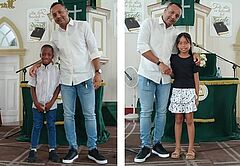
On 10 August 2025, a festival for all children attending Sunday school in the congregation was held in the indoor facilities and large outdoor grounds of the Moravian Church's youth centre in Paramaribo, Suriname, as part of the annual ‘Herrnhut Month’ in August. The theme was ‘You will be my witnesses.’ See here. The festival commemorated the children's revival in the old Herrnhut on 17 August 1727. The children of the ‘Friedrich Stahelin School’ also celebrated their annual children's festival on this Sunday in the wooden ‘Große Stadtkirche’ (Great City Church) in Paramaribo. Pictures here, several videos here. The best children from the various schools of the Moravian Church were awarded prizes and honoured with flowers for their achievements during the last school term. Davina Pengel, member of the parents' committee, was also honoured for her commitment. Football player Maycheal van der San presented the awards. Many pictures here.
Two news items from the Moravian School Foundation in Suriname
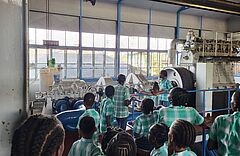
Hendrik Van Leesten, Candice Doornkamp and Magalie Oldenstam, three young people from the William Severinus Richenel Ritfeldschool in Paramaribo, Suriname, took part in the final round of the Surinamese Mathematics Olympiad on 1 and 2 August 2025. See here. The Olympiad has been organised since 2013 by the Surinamese Association of Mathematics and Arithmetic Teachers and consists of several qualifying rounds. Last year, around 1,700 pupils took part in the first round and 89 of them reached the final round. As part of the school foundation's annual career discovery days, young people from the Adolf Theodor Pengelschool in Bersaba visited the technical facilities of the Surinamese water supply company SWM. See here. Before the visit, no one wanted to pursue a career in water management, but afterwards many of the young people said they could imagine working for SWM.
Hesli Pansa steps down as head of the City Mission in Paramaribo
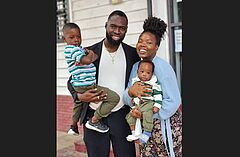
On 18 August 2025, Hesli Pansa announced on Facebook that he was stepping down as head of the City Mission of the Moravian Church in Paramaribo, Suriname, the most important institution of the Moravian Church in the country, which was founded 156 years ago and is active in a wide range of evangelical and social welfare work. See here. He writes: "Ecclesiastes 3 makes it clear to us: Everything has its time. There is a time to come and a time to go. My time to go has now come. After several years of working in God's vineyard, the City Mission, God has now called me to serve elsewhere. This step was not easy, but I am taking it after prayer and fasting. It has been a joy to serve you as head of the City Mission. In my work, I have come to know God as a God who never changes in his faithfulness. To you, my dear brothers and sisters, I would like to say that we Christians are to be salt and light in the world. I wish you God's rich blessings." A video showing Hesli Pansa recently giving a sermon can be found here.
Project for school starters in Nieuw Aurora
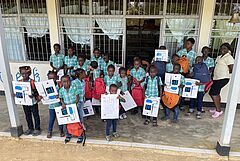
Getting children ready for primary school is a priority in many villages in the vast tropical interior of Suriname. Primary school lessons in Suriname are taught in Dutch. However, this is not usually the mother tongue of the young children. Most of the children grew up speaking Sranan. With the support of the Zeister Zendingsgenootschap, the Dutch sister organisation of the Herrnhuter Missionshilfe, a preschool education project has therefore been running for ten years – and is now starting again for eight children – in the village of Nieuw Aurora on the Suriname River, led by local teachers Shirley and Persis. A picture can be found here. A short video can be found here. Nieuw Aurora has a small airstrip in the rainforest, otherwise the village is only accessible by boat on the river. Around 2,000 people live here, most of whom belong to the Saramaccan people.
Portrait of Herman Jintie, Director of the Medical Mission in Suriname
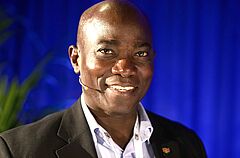
The Dutch platform Dutch Health Hub recently featured Herman Jintie, who has been head of the Medical Mission in Suriname (Medische Zending – Primary Health Care) since 2019, on its website. For more than 250 years, this organisation has been providing reliable healthcare in remote villages in the tropical interior of Suriname with 52 ambulances. Two groups of people live here: the indigenous inhabitants and the Maroons (i.e. the descendants of escaped African slaves). Herman Jintie comes from Commewijne, not far from Paramaribo. His parents were simple farmers. He actually wanted to become an economist, but had to drop out of university due to a lack of money. A friend advised him to work in healthcare. While still in training, he worked at the psychiatric centre in Suriname and then rose through the ranks to his current position as director. You can find out more about him and the organisation he heads here.
Medical mission in Suriname presents “Strategy Plan 2025–2027” to the government
"The biggest challenge for the Medical Mission in Suriname (Medische Zending - Primary Health Care) is achieving its strategic goals for the period 2025–2027. This was recently emphasized by its director, Herman Jintie, to Amar Ramadhin, Suriname's Minister of Health. He continued: “Making plans is easy, but we have to fill the plans with life, and that requires commitment, a lot of resources, and good cooperation.” The director did not hide the problems: “We cannot do the work alone.” The strategic plan is closely linked to the actions of the Ministry of Health, Welfare, and Sport, which often falls short of its promises, especially with regard to improving health care in the interior of Suriname. Logistical and personnel problems are still the order of the day there. More in Dutch in the Suriname Herald here.
Two major youth events in Suriname one after the other
The youth center of the Moravian Church in Paramaribo, Suriname, recently reported on two major youth events held on its premises and large grounds. The National Youth Conference on Saturday, July 19, 2025, was described as an inspiring day that brought together 30 committed youth leaders from several Surinamese Moravian churches. There was intensive discussion about the future of church work with children and young people, and groups drew up a plan for the next five years. A new youth board and various committees were also elected. 28 pictures here. Immediately after the conference, the youth of Paramaribo were invited to another nightly Power Hour (praise hour). The theme of the balmy night was All White Praise Party. There was song and music by Raff Chanco & The Musical Youth of God. Also present were Eugene Main and Kennia Domini. A 40-minute video here. 42 photos here. More music here.
Dutch Army Medical Corps returns to Suriname
For the fourth time, members of the Dutch armed forces provided medical assistance in the interior of Suriname. The online forum waterkant.net reported on June 30, 2025: "Two women and a man from the Dutch Army Medical Service have been working tirelessly for the past eight weeks in the ambulance of the Medical Mission in Suriname in Brownsweg in the tropical rainforest. Despite limited resources, the team, together with local staff, managed to provide essential nursing care under difficult conditions. The temporary deployment of the army team not only relieved the Surinamese health care system, but also trained the Dutch team's ability to improvise, according to the Dutch Embassy in Suriname. Seven more medical soldiers from the Netherlands are expected to arrive in Suriname soon. See here.
Digital tool for school improvements in Suriname
The Moravian Church's school foundation in Suriname (Stichting Onderweijs der EBGS) has provided teachers at its 65 schools with a new digital tool via Facebook. See here. The foundation writes: "All the tests taken by students provide a wealth of data. But how can this data be transformed into targeted educational action? How does a teacher get from performance trend analysis to team discussions with other teachers? And how can schools ensure that key educational priorities are firmly anchored in the minds and hearts of all teachers?" A digital tool for quality control and quality assurance (Kwaliteitszorg: zicht op je onderwijs) is being introduced. The description states: “Discover how feedback from students, parents, and teachers can become a driving force for school development: with intelligent formats, context-oriented questionnaires, and understandable visualizations for practical use.”
Even more children's Bibles for the Trio people in Suriname and northern Brazil
The Zeister Missionsgesellschaft, the Dutch sister organization of Herrnhuter Missionshilfe, reported on June 4, 2025: "The 400 reprinted children's Bibles in the language of the Trio people have now arrived in Suriname and are being transported to the village of Sipaliwini. From there, they will be taken by canoe and on foot to the isolated Trio communities in the tropical rainforest on the border between Suriname and Brazil. Among the Trio, children's Bibles are read not only by children, but also by adults who never went to school. By the end of 2025, all Trio children should have access to the Gospel. Every year, the Trio hold a Bible conference where indigenous people from many villages come together. For a week, there are daily church services with music, dancing, and encounters. Another Bible conference is planned for August 2025. Take a look at the children's Bible here. Watch a video of a Trio church service here.
Help for the Deaconess Hospital in Paramaribo
The Deaconess Hospital in Paramaribo is one of the most important medical facilities in the Republic of Suriname. Founded more than 60 years ago under the auspices of the Moravian Church and its mission, the facility now has 210 beds. The hospital management writes about the current economic situation: "The economic crisis and the outbreak of the COVID-19 pandemic have had a negative impact on the financial situation of our hospital. We no longer have any reserves to carry out major maintenance or necessary (replacement) investments." The Zeister Missionsgesellschaft, the Dutch sister organization of the Herrnhuter Missionshilfe, wants to help in this difficult situation. One of its projects involves replacing the ventilation and air conditioning systems in two operating rooms. This is the only way to ensure the safety of patients, doctors, and nursing staff. The Zeister Missionsgesellschaft would like to invest $5,000 in good nursing care in Suriname. It is asking for donations. See here.
Medical mission in Suriname still in a difficult situation
The Suriname Herald published two articles on the critical situation of the Medical Mission in Suriname (Medische Zending). On May 22, 2025, the focus was on the state's outstanding payments to the aid organization. See here. The state owes the organization the adjustment of its payments to the wage increases for July to December 2024 and the promised inflation compensation for April and May 2025. On May 29, 2025, the newspaper reported on the inadequate supply of medicines in the structurally weak tropical inland country. See here. In many places, not even the bare essentials are available. “There is a list of essential medicines that must be available in every ambulance, as well as standard medical supplies. But we don't have enough of them. This problem remains unresolved,” said Maureen Wijngaarde-van Dijk, the head of the organization.
The Friedrich Staehelin School in Paramaribo has been given a fresh coat of paint
The Paramaribo Central Lions Club has supported several projects run by the School Foundation of the Moravian Church in Suriname. Now, before the summer holidays, the club's donations have been used to fund a new project for the Friedrich Staehelin School, a primary school in the center of Paramaribo: repainting the entire exterior of the school. Some of the pupils gathered on the school steps. See here. The following message was posted on Facebook: “We, the teachers and students of the Friedrich Staehelin School, would like to express our sincere thanks for the wonderful repainting of the school. It was wonderful that the finished project could be handed over to us today. We wish the club good luck with its next projects. God bless you!” A short video can be found here.
Forty new mattresses for the “Saron Children's House”
Last year, the Moravian Church's Saron's children's home in the Surinamese capital of Paramaribo had requested 31 new mattresses for the beds of the boarding school children, as the majority of the old mattresses had long since become outdated and were barely usable. Now, with the help of the Zeister Missionsgesellschaft, the Dutch sister organization of Herrnhuter Missionshilfe, 40 new mattresses have been procured and delivered by the company M.A. Madhar's in Suriname. From Paramaribo we heard: "The mattresses and mattress covers were immediately put to use by the children. The children enthusiastically helped to unload the mattresses and put new ones on their beds. And of course there was also a test bed. With broad smiles, the children discovered that the new mattresses were wonderful to lie on." Some pictures here.
New roofs for a safe home in “Huize Francis”
Huize Francis is a retirement home run by the Moravian Church in Suriname. It is located in Nickerie in the north-west of the country and has been providing a comfortable home for elderly people in need of help but not care since 1976. Now the roofs of the facility urgently need to be replaced. The wood of the old roofs is rotten; it has termite damage and already has several holes. All of this threatens the safety and security of the residents. The Zeister Zedingsgenootschap, the Dutch sister organization of Herrnhuter Missionshilfe, is supporting the roof renovation of Huize Francis with a substantial amount so that the elderly do not have to worry in the future. The initiative to found the facility came from Pastor Rudy. F. Polanen. The facility currently has 22 places. A video of the facility here.
“Julius-Theodor-Wenzel-Schule” celebrates its 120th anniversary
The School Foundation of the Moravian Church in Suriname commemorated the 120th anniversary of the founding of what is now the Julius Theodor Wenzel School in Paramaribo. On Facebook it said: "The school was founded on May 25, 1905 as Annieschool and was only intended for British-Indian and Javanese children. About 60 children attended. The first girl to be admitted was called Annie. That is why the school was named after her. On November 25, 1963, the school was renamed the J. Th. Wenzel School. Julius Theodor Wenzel, the son of a Herrnhut missionary, studied Indian languages and religion in Berlin, among other places. He returned to Suriname in 1901 and worked for the Moravian Church throughout the country. This missionary did groundbreaking work among the thousands of Indian contract workers who worked on the plantations in Suriname." He founded the anti-government organization Ikhtiyar aur Hakh (Freedom and Justice), a kind of trade union for the exploited contract workers and their families. He died in 1921.
Moravian Church in Suriname
The Moravian Church in Suriname is not only the largest Protestant church in Suriname, but also one of the most important social forces in the country. Most of the congregations are in the capital Paramaribo and on the coast, where more than 90% of the inhabitants live. Even more formative for the everyday life of the people is the Moravian Church in the settlements along the great jungle rivers, most of which can only be reached by boat. Here there are churches and parsonages everywhere; here there are preschools and schools; here there are some vocational training centers and many infirmaries; here the Moravian Church is involved in local politics.
Including the schools in the cities, the Moravian Church runs 73 schools in Suriname, with about 16,000 students. The Moravian Church also runs several children's homes and a home for the elderly. In Paramaribo, the Moravian Church shares responsibility for a hospital.
Unity province since 1963
In 1963, an independent Unity Province was created in Suriname from a former mission area, which cooperates with West Indies East, Jamaica, Nicaragua, Honduras and Costa Rica in the Caribbean Regional Conference. The church leadership, headed by a praeses, is based in Paramaribo. The province had about 20,000 members in 67 congregations plus some outstations in 2023. There are 38 ordained pastors serving in the province, most of them of advanced age. In addition, more than 13 lay people serve in the congregations. 15 parish districts of varying sizes exist in the narrow coastal strip and the vast inland area.
The first ordination of a native pastor took place as early as 1902, the first consecration of a native bishop in 1962. For the training of its young theologians as well as for the further education of other collaborators, the province of Suriname maintains its own theological seminary in Paramaribo, which began in 1930 and has existed in its present form since 1976. In addition to the territory of the state of the same name on the American mainland, the Unity Province of Suriname also includes the Antillean islands of Aruba, Curaçao and St. Maarten.
unique features
Within the worldwide Moravian Church, the Province of Suriname has some unique features:
- Nowhere have so many employees been sent within two centuries as to Suriname.
- Nowhere has the mission cost as many victims as in Suriname; in the first years, 71 mostly young men and women and 15 children died because of the difficult climatic conditions.
- Nowhere in the world does the Moravian Church have such a strong folk-church character as in Suriname. It is deeply rooted in all parts of the country, ethnic groups and social classes.
- Nowhere else is there a moravian concern, the company C. Kersten & Co, which dates back to the missionary period and whose profits significantly feed the Moravian Church Foundation MCF (foundation of the worldwide Moravian Church).
- Through no other province has the work in the native Europe been so strongly influenced as through the province of Suriname. Due to immigration to the Netherlands, the majority of the members of the European-Continental Province today have a Surinamese background.
Mission activities
Like most Unity provinces, the Suriname Province is missionary active. In the late 1980s, it began work in neighboring French Guiana. While this work was initially almost exclusively a collection effort among civil war refugees, since 2006 it has been building up congregations, which has already led to a formal congregation planting in St. Laurent. In addition, work is being done among bauxite miners in the interior in ecumenical fellowship with other churches.
early Mission History
Suriname, then a Dutch colony, is the third country to which Moravian missionaries came. Formal mission was not allowed at the beginning, so the colonist work was to see if among the "savages" (Indians) and "Moors" (slaves imported from Africa) "someone could be won for the Savior". After two unsuccessful attempts (1735 and 1738), it was only in the following period that a permanent settlement succeeded in Paramaribo as well as on the plantation Altona, and later on other plantations. As a side branch of the work in Suriname, the congregation Pilgerhut flourished for a quarter of a century in neighboring Berbice, where 386 Arawakken received baptism.
Because the missionaries had to earn their own living, there was a conducive coexistence of trade and commerce on the one hand and preaching on the other in Suriname. By practicing agriculture or a trade on the plantations, the missionaries provided an important piece of training and development aid for the locals. The linguistically skilled theologian Theophil Salomo Schumann wrote an Arawakk grammar and dictionary. Another important person at the beginning was the tailor Ludwig Christoph Dehne. There were repeated setbacks due to the death of missionaries, their wives and children, who could not cope with the tropical climate as well as the heavy physical labor.
As colonization progressed, the native Indians got caught between all fronts and were ultimately expelled or murdered, so the missionaries could no longer turn their attention to them. Instead, their attention turned to the creoles, the black city and plantation slaves, as well as the bush negroes, now called maroons, who had fled into the jungle. 300 kilometers deep in the jungle, the baptism of the chief's son Arrabini, the first important native employee, took place in 1765. Work also flourished in Paramaribo. At last, there were economic and missionary successes on the coast and on the plantations along the great jungle streams, due not least to the work of the capable Christoph Kersten, who in 1768 founded the C. Kersten & Co company, which has been highly successful to the present day. In 1778, the first wooden church was built in Paramaribo. In 1790, the first independent regional leadership was constituted, the so-called Helper's Conference. By 1800, 21 missionaries were serving about 600 church members in four stations. However, the white plantation owners were almost always critical of the missionary work.
In Paramaribo, the wooden Great City Church with 1,100 seats represents something like the center of the Moravian Church, the "Mama Kerki". Here are also the Theological Seminary and the City Mission of the Moravian Church, with which manifold social responsibilities are carried out.
The Moravian Church is economically active in Paramaribo and in some other places. One of the largest companies in the country is the former missionary company C. Kersten & Co., founded as early as 1768. Today it is a holding company for a wide variety of economic activities at home and abroad, with more than 550 full-time jobs, including the famous CKC Supermarket in the center of Paramaribo.
Suriname booklet from Switzerland
The Moravian Church in Switzerland publishes a brochure entitled herrnhuter. The 15th issue of April 2018 deals with Suriname on the occasion of the World Day of Prayer. Contents: John Kent preaches - basic data on the country - Anneli Vollprecht gives an overview of mission history and tells about the Moravians in Suriname today - Hans-Beat Motel outlines the business enterprise Kersten & Co - word from the church leadership on the 150th anniversary of the abolition of slavery - song from Suriname. - The booklet is not available for download. If you are interested in it, you can order it for free delivery from Volker Schulz in Basel. Tel.: +41 61 273 40 74; e-mail schulz(at)Moravian.ch. A donation is welcome.
further information
The Zeister Zendingsgenootschap ZZg, the Dutch sister organization of Herrnhuter Missionshilfe, is responsible for maintaining relations with the Unity Province of Suriname in the European Province.
On the website of the ZZg there is a wealth of information in Dutch about programs and projects in Suriname.
More materials
- Film der Deutschen Welle über die Arbeit der Herrnhuter in Suriname (26 Min.)
- Länderinformation der HMH zur Brüdergemeine in Suriname, (PDF, ca 400 kb)
- Powerpointpräsentation Suriname - Land der Vielfalt im Norden von Südamerika mit Begleitheft
